10 tips on how to cover the roof of the gazebo in the country + photo
The roof of the gazebo, if it is made of reliable material, will become protection against raindrops and the scorching sun, thereby ensuring the comfort of rest in any weather. Probably, it will be superfluous to say that the roof should be of high quality, durable, strong and outwardly attractive, combined with wall material and harmonize with site landscape- This is well understood by everyone. All that remains is the question of how to cover the roof of the gazebo to ensure compliance with all these requirements. Consider all possible options to find the perfect for gazebos of different sizes, shapes and styles.
No. 1. What should be considered when designing the roof of the gazebo?
Choosing the material for the roof of the gazebo, consider the following nuances:
- preference is best given as much as possible lighter materialswhich does not require reinforcing the structure of the frame and walls, erecting a complex foundation;
- when the gazebo is located near pond, choose the most resistant to moisture. Additional treatment with antiseptics and water-repellent impregnations will not hurt;
- gazebos with barbecue require the use of fireproof material for roofing. This is slate, tile, but in no case straw or wood;
- roof material should be combined with the walls of the gazebo surrounding the buildings and landscape generally;
- important to take into account climate of the region, especially choosing the angle of the roof. If there is a lot of snow in winter, then the slope should be significant so that the snow can freely come off the roof. For windy regions, more gentle roofs are chosen or, if this is not possible, they protect the roof from windage.

No. 2. Arbor roof shape
The choice roofing material to a large extent depends on its shape and design. What shape can a roof be and what kind of roofing material is suitable in each particular case?
- pitched roof - The simplest option, with the arrangement of which it is quite realistic to cope with your own hands. Such roofs are used for quadrangular arbors, the design is based on opposite walls of different levels. The side and angle of inclination are chosen taking into account the wind rose, so that the roof can protect against oblique rain;

- gable roofs - Another simple and fairly common option, suitable for rectangular arbors, easy to arrange, but has some drawbacks. With a slight slope, normal snow flow is not ensured, and with a sufficient slope, the overview of the territory from the gazebo is reduced, so such designs are not suitable for all regions;

- four-pitched (hip) roof in the arrangement is already more difficult, therefore it is not common. Such a roof consists of two trapezoidal parts and two triangular, used in the construction of rectangular or polygonal arbors;

- hipped (domed) roof consists of four or more slopes of a triangular shape that converge at one point. Such structures have excellent aerodynamic properties and with sufficient overhang reliably protect from winds and precipitation;

- round roof - One of the most difficult options in arranging, depending on the angle of inclination, has the shape of a cone or helmet, it differs in its original appearance.

Deciding how to cover the roof of the gazebo is possible only when the shape of the roof is determined. For pitched structures, it is better to choose sheet material: slate, professional sheet, metal tile, although other roofing materials will do. For tent, multifaceted and hip roofs, sheet material is inappropriate to use: the work will be complicated and there will be a lot of waste, so materials from the soft roof class, for example, bitumen shingles, are suitable.
No. 3. Metal tile for the roof of the gazebo
Metal tile - A leader in the world of roofing materials, and it is also used to equip arbors. This material will be especially useful when the roof of the house is also made of metal. This sheet material is usually made of galvanized steel, several layers of protective coatings are applied on top, and due to its characteristic relief, it is very similar to tile.
Benefits:
- light weight, simplicity and speed of installation;
- wide range of colors and profiles;
- durability, up to 20 years;
- environmental friendliness;
- resistance to negative environmental factors due to the layers of the protective coating - precipitation, temperature changes and direct sunlight are not terrible for the metal tile;
- ease of maintenance;
- low cost.

Minuses:
- noise during rain;
- a large amount of waste during the arrangement of roofs of complex shapes, which can negate the benefits of low prices;
- the risk of corrosion if the protective coating is broken;
- the angle of inclination of the roof of the gazebo should not be lower than 15 degrees, so that the snow can move normally, otherwise the beautiful relief of the material will only harm.
Number 4. Profiled sheet for the roof of the gazebo
Professional sheet or professional flooring even cheaper than metal, and in many respects these materials are similar. Professional sheet made of cold rolled steel, on which several layers of protective coatings are applied. The relief, as a rule, is represented by waves or trapezoids, and the function of increasing the strength of the material is assigned to it. In terms of decorative qualities, the profiled sheet is inferior to the metal tile, and among its main merits:
- affordable price;
- durability;
- large selection of colors;
- low weight and ease of installation;
- resistance to corrosion, temperature extremes, precipitation.
To not the prettiest appearance is added disadvantage, typical for metal, - noise during rain. You can try to use vibration isolation pads, but they are not able to completely solve the problem. It is better to choose thicker sheets, since thin material is subject to mechanical damage and cannot be repaired. The metal roof heats up quickly, which means that on a hot sunny day it will be impossible to be in the gazebo, therefore this option is suitable for structures located in the shade.
No. 5. Flexible roof tile
Flexible tileshe soft tile, it is a bituminous tile - a material that is produced on the basis of fiberglass, which is processed with bitumen and stone powder. Material refers to type soft roof and represents small modules of rectangular, hexagonal or other shapes. They overlap and are suitable for arranging roofs of the most complex forms, so if you do not know how to cover the roof of the arbor of a dome shape, then this is the best option.
Benefits:
- a wide variety of colors and shapes. Soft tiles are available in almost all shades, and the shape can be either simple rectangular or diamond-shaped, or complex (beaver tail, dragon tooth, hexagon);
- light weight;
- complete silence - even heavy rain will not drown conversations in the gazebo;
- durability, up to 30 years;
- simple and virtually waste-free installation.

disadvantages:
- the need to create a solid base of moisture resistant plywood;
- high price. Bituminous tiles are more expensive than metal tiles, but the entire installation, taking into account the arrangement of a solid base, will cost less than the use of ceramic tiles;
- strong winds can break the modules of soft tiles.
No. 6. Slate for a roof of an arbor
We are talking about asbestos-cement slatefamiliar to all of us. This sheet material is made of cement, water and asbestos, can be painted in the necessary shade so that the gazebo does not seem boring. The paint layer, by the way, allows you to give the slate additional strength characteristics.
pros:
- low price;
- durability, up to 40 years;
- good strength;
- resistance to precipitation, frost and fire. If the gazebo will be barbecue or barbecue, you can choose slate as a roof;
- low thermal conductivity, which helps to maintain an optimal microclimate.
Minuses:
- poorly suited for small arbors and for arranging complex roofs;
- fragility;
- heavy weight will require a reliable crate;
- low aesthetic qualities.

Number 7. Ondulin for the roof of the gazebo
Ondulin - the most popular representative euro slate, was created by the French company Onduline, in whose honor it is named. Often the material is also called bituminous slate or soft slate. It is made on the basis of cellulose fibers, which are mixed with mineral components, after which the formed sheets are impregnated with bitumen and painted in the desired color. Using bitumen allows you to create a completely waterproof material, which is lightweight, light and soft. Among the others advantages of ondulin:
- low cost;
- good noise isolation and the absence of unpleasant noise during rain;
- simplicity of processing and installation;
- flexibility, so with the help of onudlin it is possible to arrange arbors with a complex shape of the roof;
- resistance to precipitation and corrosion.

Minuses:
- combustibility, therefore, for a gazebo with barbecue is not suitable;
- the ability to fade when exposed to sunlight;
- the need to equip the crate with a pitch of at least 0.6 m.
Number 8. Polycarbonate for the roof of the gazebo
Recently, polycarbonate is increasingly being used to equip arbors, and is suitable for organizing both walls and roofs. It is a flexible sheet of translucent material of any shade.
pros:
- variety of colors;
- durability;
- precipitation stability. Fragile-looking polycarbonate can withstand a decent layer of snow and gusts of wind;
- light weight;
- flexibility to equip a fancy-shaped roof.
disadvantages:
- low resistance to mechanical damage;
- the ability to deteriorate under the influence of sunlight, so it is necessary to make sure that there is a protective film when buying;
- if the gazebo is installed in a place protected from the wind, then on a hot day it will be stuffy. Remember, not in vain polycarbonate is used in the construction of greenhouses;
- you can’t put a barbecue in the gazebo with such a roof.
Light transmission can play into the hands in the evening, because sunlight can be used to the maximum. On the other hand, such a canopy will not protect against the scorching sun. Sometimes polycarbonate combine with art forging.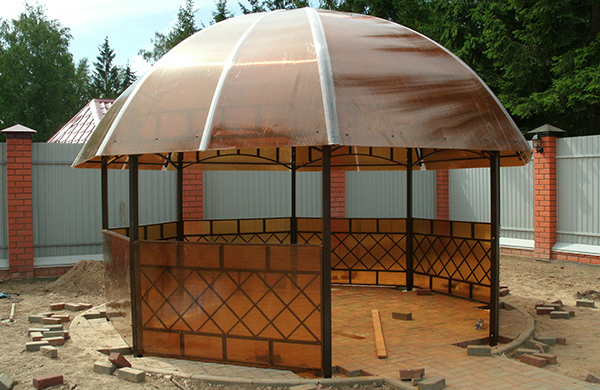
No. 9. Natural tile for pergola
For those who have sufficient means, and want to get a functional and beautiful gazebo, perfect natural tile – almost perfect roofing material. It can be ceramic or cement-sand, and among main advantages note:
- excellent appearance and environmental friendliness;
- resistance to moisture, heat, temperature extremes, fire;
- durability, up to 100 years;
- high strength;
- good heat and noise insulation properties. The air in the gazebo will not get very hot in the heat, and raindrops will not cause a booming noise;
- the possibility of arranging roofs of complex shapes;
- maintainability, because in which case one or more damaged elements are easy to replace.
Unfortunately, and here not without cons:
- high price;
- heavy weight, complexity of installation and increased requirements for the foundation and walls of the gazebo.

No. 10. Original materials for the roof of the gazebo
The choice of traditional materials is great, but if among them you never found one that could cover the roof of the gazebo, then perhaps find a suitable solution from less common materials:
- the cloth it is usually used for arrangement of temporary portable arbors which put on a dacha only in the summer period. A dense acrylic fabric, which has undergone treatment with water-repellent substances, is usually used for this. It does not get wet, does not fade and does not fade, it can be of any shades and will be an excellent decoration for the gazebo. Less commonly used raincoat fabric, which also perfectly repels water, but differs in more modest aesthetic qualities;

- wooden shingle It is a small plank, shingles, up to 2 cm thick, mounted on a crate, allows you to create original roofs for gazebos in ethnic style. This eco-friendly material is today at the pinnacle of popularity;

- straw, reed and reeds allow you to create a nice cozy gazebo in country style. The lathing is mounted with a step of 35 cm. If it is good to ram the straw or reed, then they will catch fire with difficulty, but it does not interfere with treating the material with flame retardants just in case;

- Living roof settles down at creation of "live" arbors. It is difficult to form, misses raindrops, but in such a gazebo it will be especially cozy and cool on a hot day. You can also use climbing plants, which will braid the frame and create a dense green canopy.

When choosing the right roofing material for the gazebo, consider the style of the site and the material of the walls. For example, eco-style involves the use of only natural materials (straw, shingles, tiles), and hi-tech allows you to safely use polycarbonate, a light straw roof is suitable for vine walls, and a slate or tile roof for brick walls. The gazebo can be decorated with a weather vane, flowers and thin air curtains.

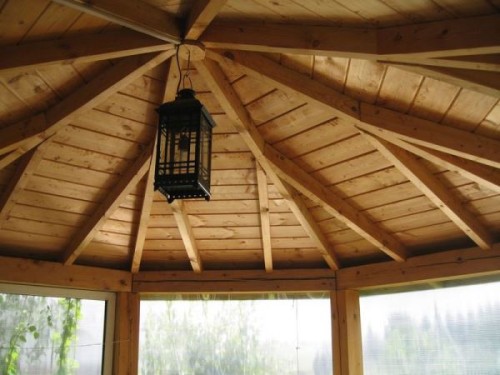
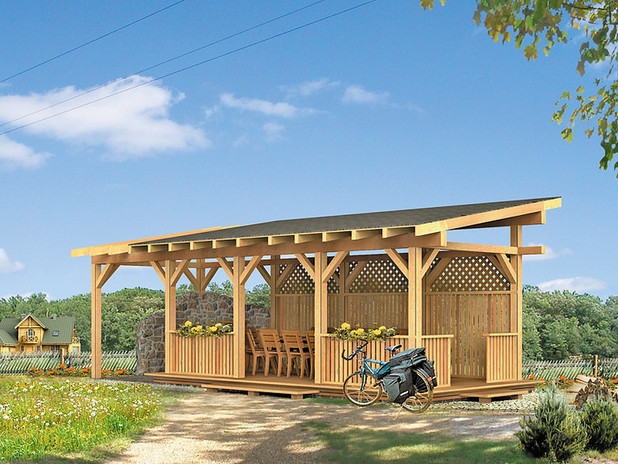

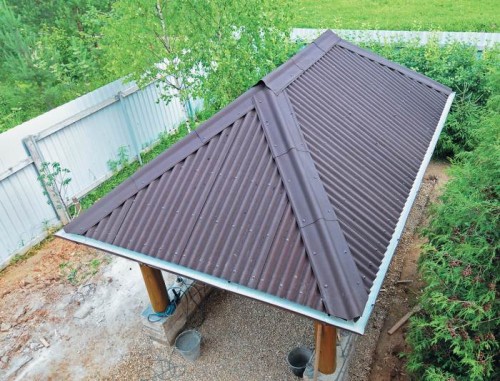
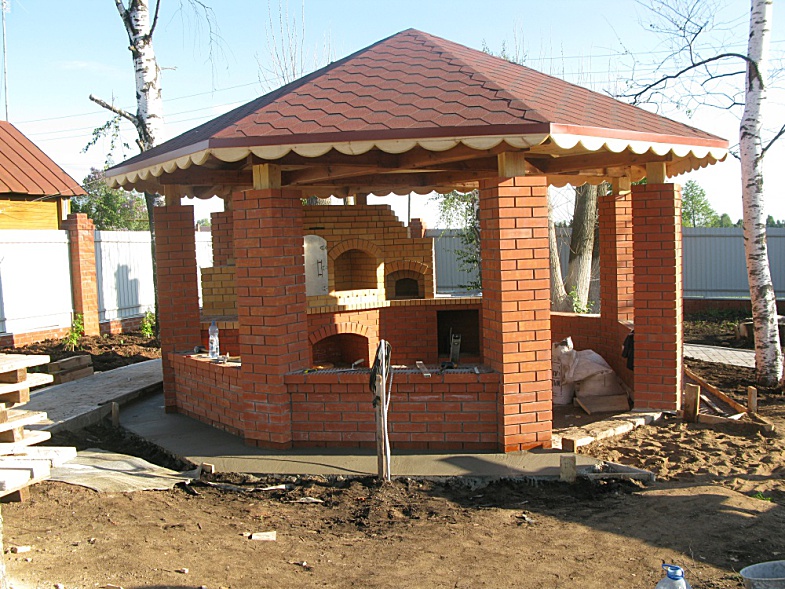
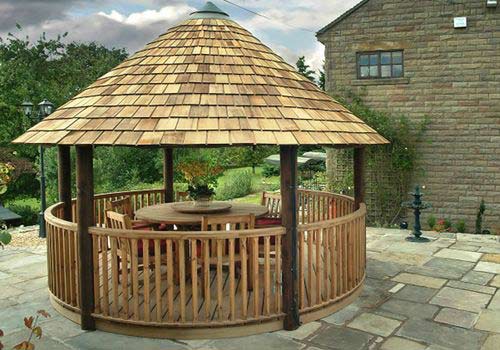
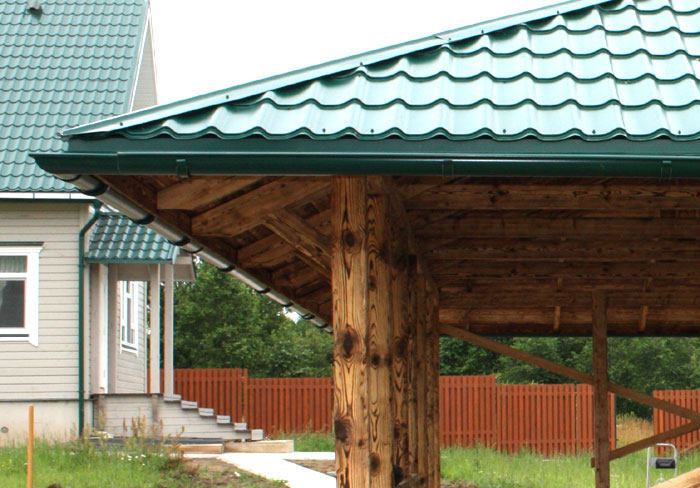

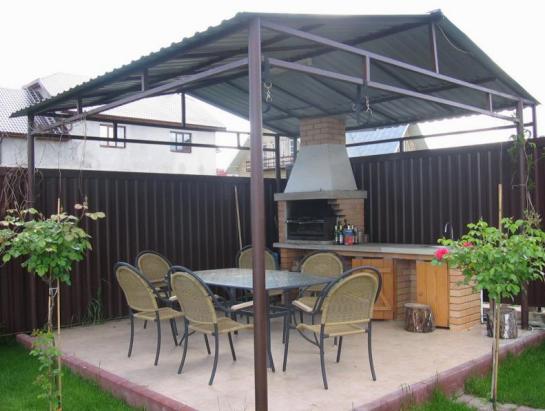
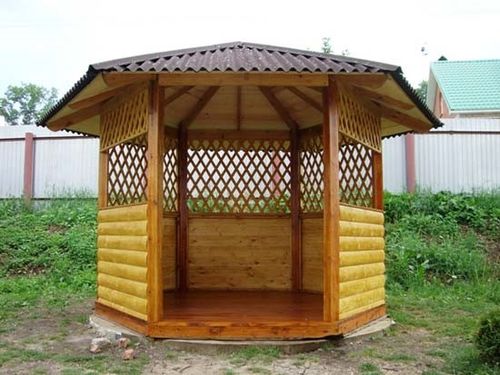
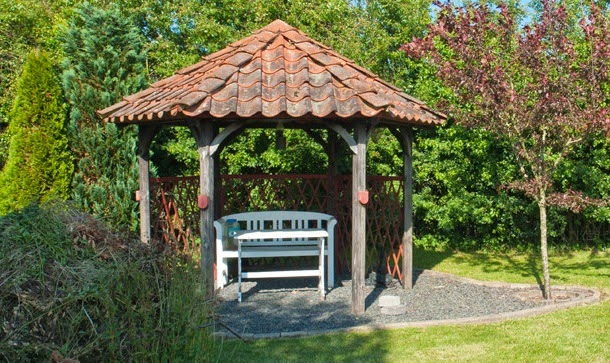
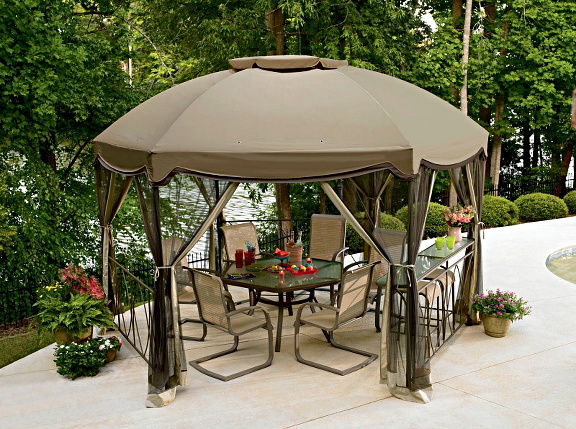
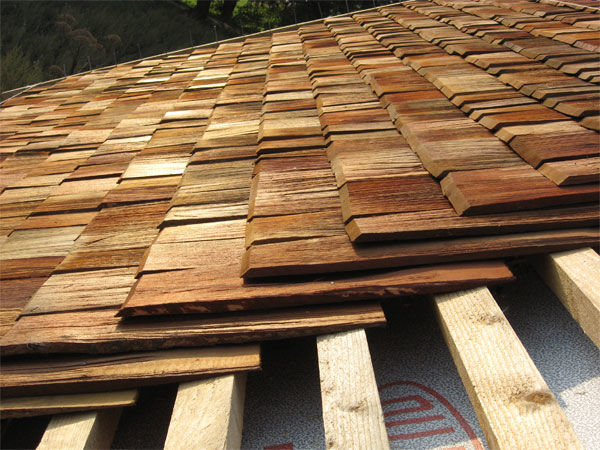
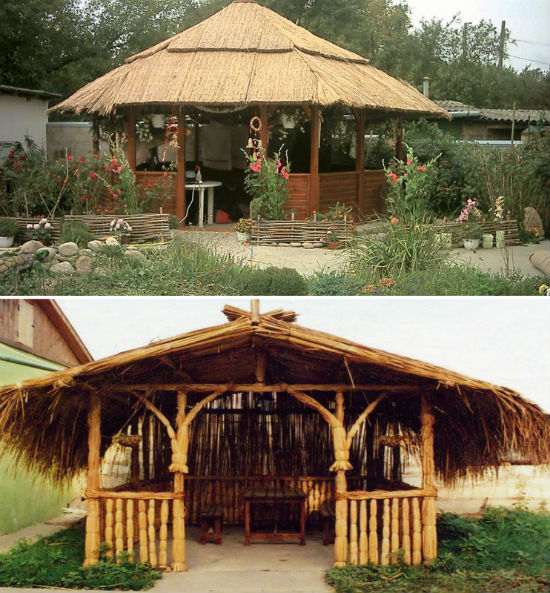
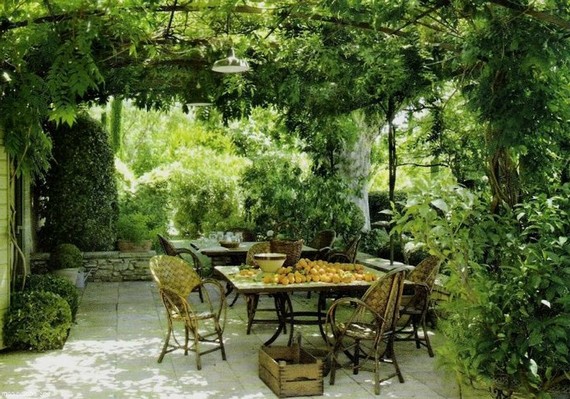

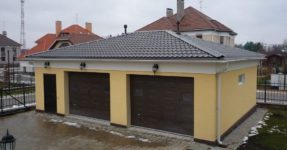
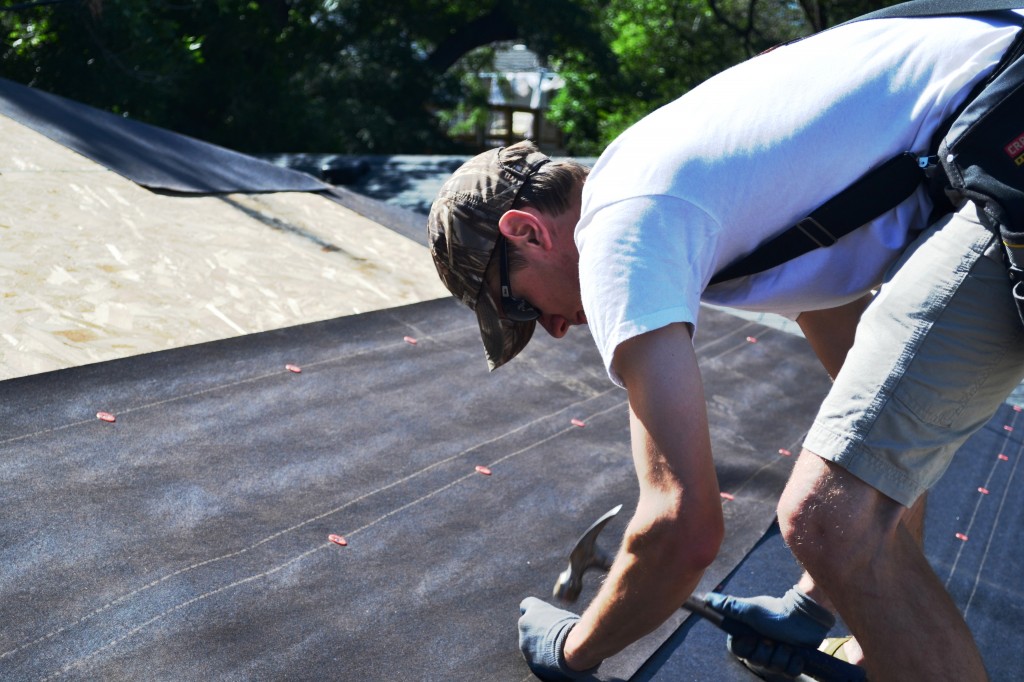

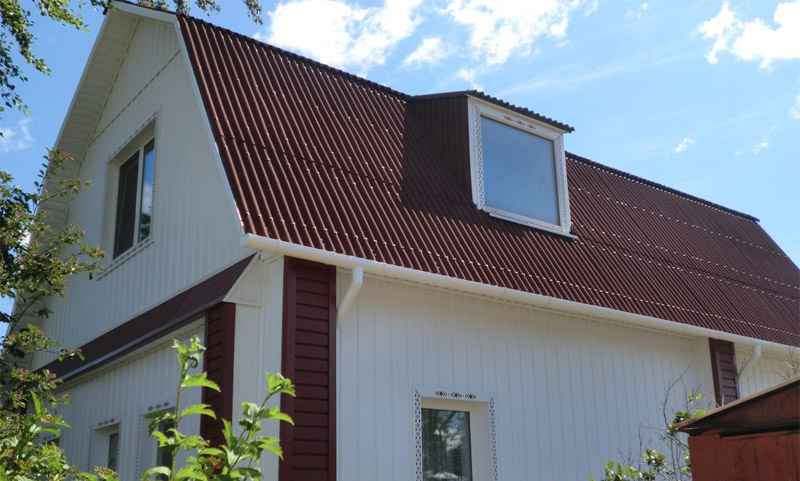
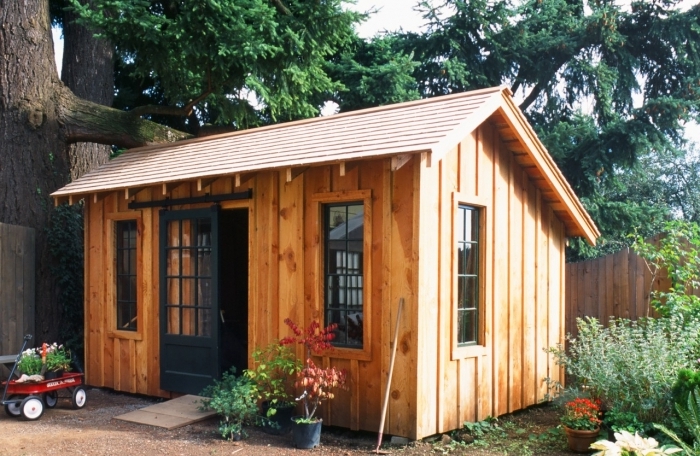
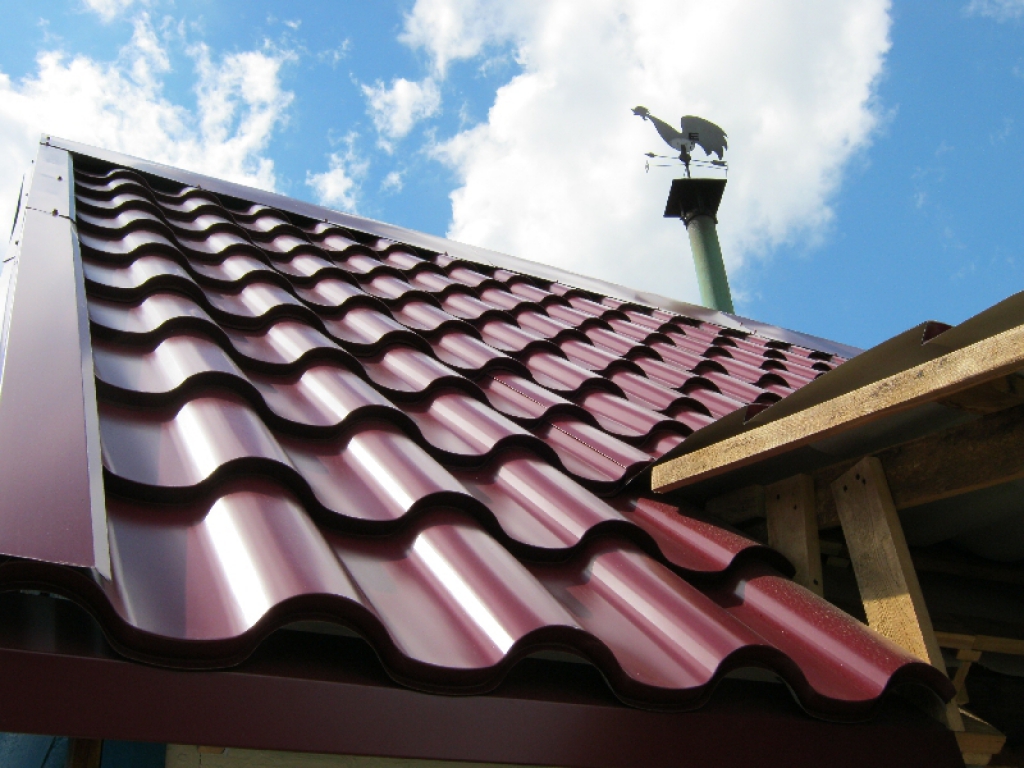

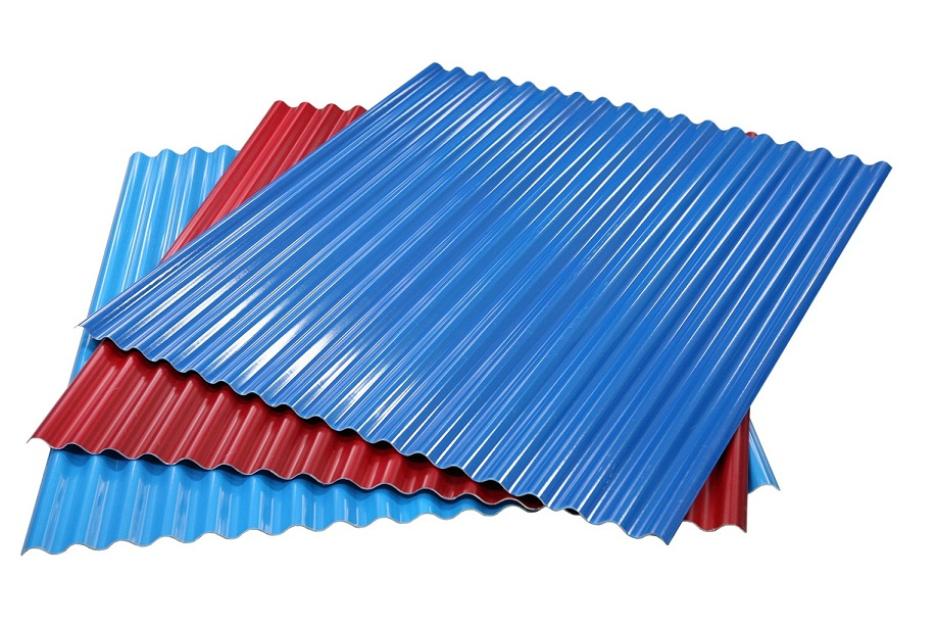
For a long time I could not decide on the type of cover of the gazebo, now I know exactly what to do. Cool article, thanks!